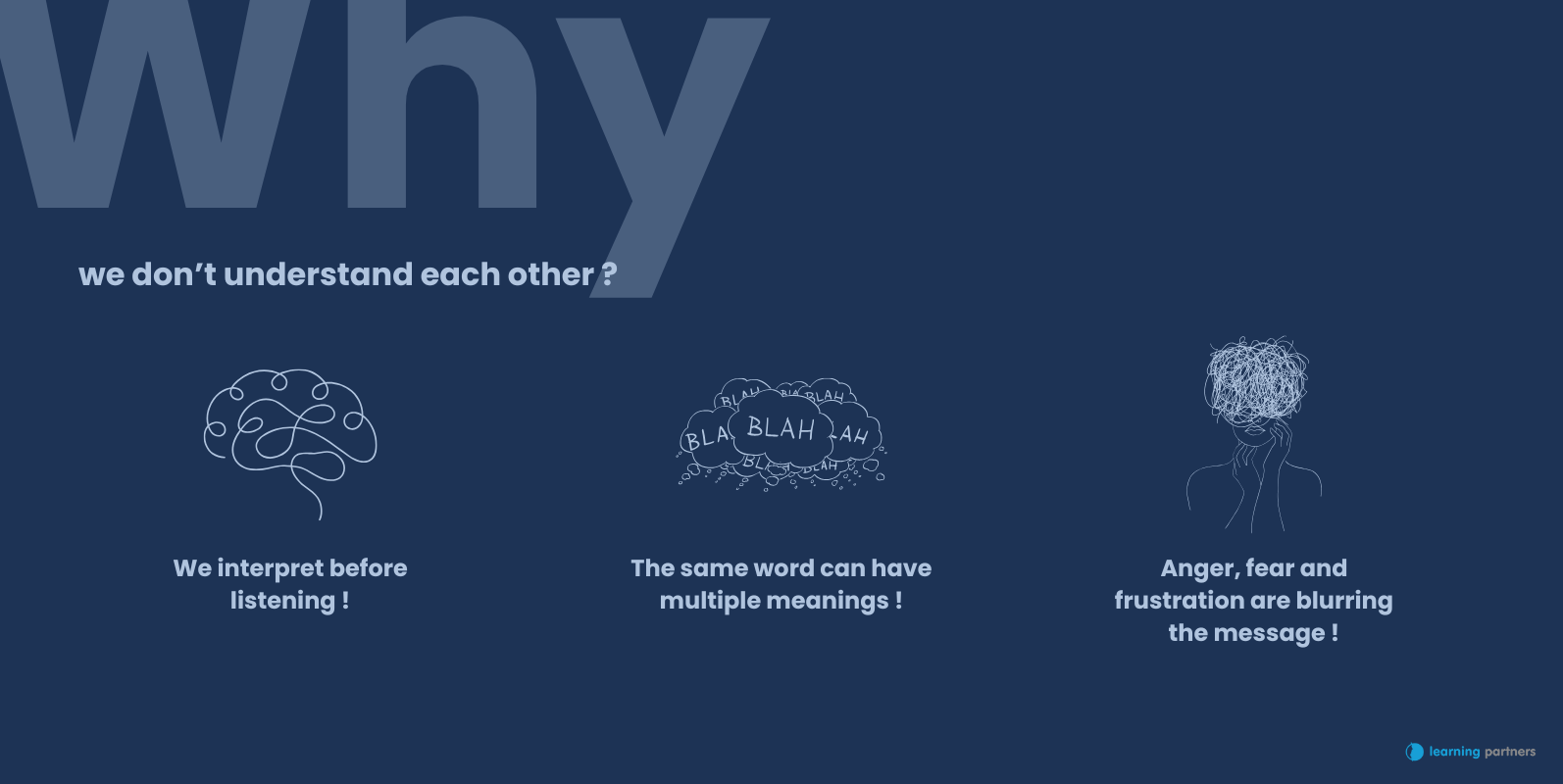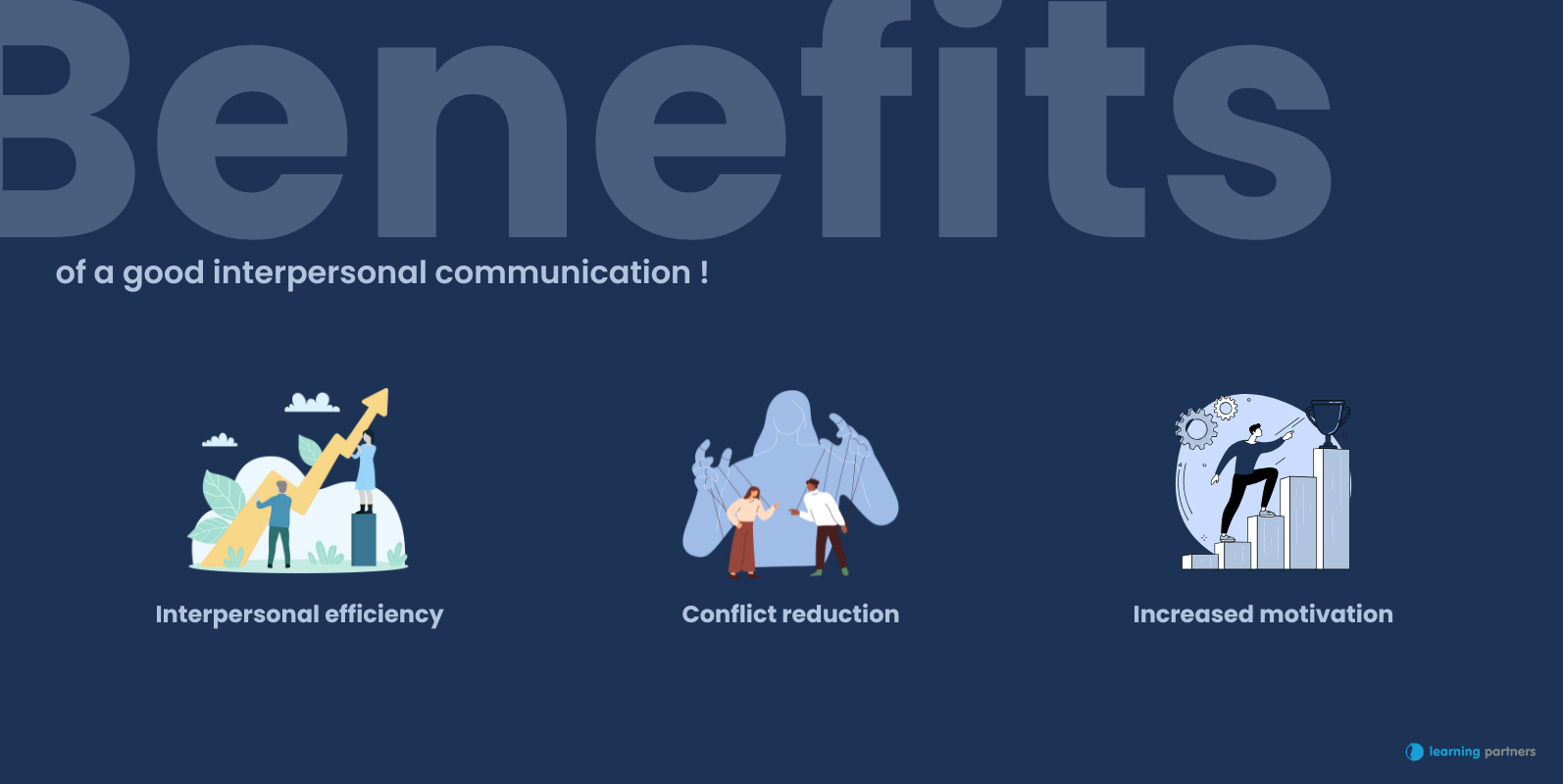Contents
Why is interpersonal communication so often misunderstood?
Understanding the fundamentals of interpersonal communication
The main obstacles to interpersonal communication
How to overcome the obstacles of interpersonal communication?
The benefits of interpersonal communication
Better communication: a lever for harmonious relations
Why is interpersonal communication so often misunderstood?
Interpersonal communication is at the heart of our daily relationships, whether personal or professional. Yet, despite its central role in our lives, it is frequently a source of misunderstanding, frustration and even conflict.
Why? Because good communication isn’t innate: it involves understanding a complex process, influenced by multiple factors, verbal and non-verbal, emotional and cognitive.
Understanding the obstacles that stand in the way of our exchanges is the first step to developing effective, benevolent and constructive communication.
In this article, Learning Partners guides you through the main obstacles to interpersonal communication and suggests concrete solutions to overcome them.
Learning Partners is your partner in relational and managerial strategy!
We work with you, within your teams, to help you interact more effectively and better understand the obstacles to your performance. Together, we co-implement tools and methods to enhance your performance!
With over 20 years’ experience in the field with major companies, our mission is clear: to put our expertise to work for your teams and your development.
Understanding the fundamentals of interpersonal communication
Interpersonal communication is at the heart of all our relationships, whether professional or personal. To better interact, cooperate or manage conflict, it’s essential to understand the basics: verbal, non-verbal, active listening and the relational framework. Let’s decipher these essential basics.
Verbal and non-verbal communication: two inseparable pillars
Communication is more than just words. Body language, facial expression, gestures, tone of voice, silences: these are all non-verbal elements that enrich or contradict our speech. Effective communication therefore requires the alignment of verbal and non-verbal elements.
The communication process: from sender to receiver
To communicate is to transmit a message from a sender to a receiver, via a channel. This process is influenced by context, personal filters (beliefs, emotions, experiences) and feedback. A simple failure at any one of these stages can degrade the quality of the exchange.
The challenges of interpersonal communication in human relations
Communication is the fundamental tool for bonding, collaborating, resolving conflicts, sharing ideas and inspiring. It conditions the quality of our relationships and our effectiveness in all spheres of our lives.

The main obstacles to interpersonal communication
Misunderstandings, judgments, poorly managed emotions… Interpersonal communication is often hampered by obstacles that hinder the quality of exchanges. Identifying these obstacles is essential to better understanding the other person, preventing conflict and strengthening the relationship.
Language barriers and lack of clarity in the message
Using overly technical language, vague vocabulary or ambiguous phrases makes the message difficult to understand. A lack of structure or an overly long speech can also lose the listener.
Cognitive filters and personal interpretations
Everyone filters reality through their beliefs, experiences and values. These filters influence the way we receive a message. For example, constructive criticism can be perceived as a personal attack.
Unmanaged emotions and their impact on the message
Anger, stress or fear can distort the way we express ourselves or listen. A strong emotional charge undermines the objectivity of the exchange.
Lack of active listening
Many listen to respond, not to understand. Interrupting, multitasking or mentally preparing one’s response is detrimental to truly attentive listening.
Cultural and social differences
Non-verbal codes, ways of expressing oneself, the importance of silence or physical proximity vary from culture to culture. Misinterpreting them can lead to misunderstandings.
Problems related to non-verbal communication
Body language that contradicts verbal discourse (e.g., saying “I’m fine” while withdrawing into oneself) creates dissonance. Intonation, posture and gestures influence the credibility of the message.
Incompatible communication styles
A person with a direct, assertive style, but uncomfortable with the unspoken, may find it difficult to interact with a passive-aggressive interlocutor. The discrepancy between a need for clarity and a tendency towards indirect avoidance can generate frustration and blockages.
Disruptive environments
A noisy environment, ambient stress, accumulated fatigue or frequent interruptions disrupt attention and the quality of exchanges.
Unresolved interpersonal conflicts
Latent tensions or unexpressed antecedents can pollute current exchanges. The unspoken is one of the greatest enemies of healthy communication.

How can we overcome the obstacles to interpersonal communication?
Tensions, misunderstandings, misunderstandings… Interpersonal communication can quickly become complicated if certain obstacles are not identified. To re-establish fluid and effective exchanges, it is essential to understand these obstacles and adopt concrete strategies to overcome them.
Developing active and empathic listening skills
Active listening means paying full attention to the other person, without judging or interrupting. Rephrasing, asking open-ended questions and using silence strategically foster genuine mutual understanding.
Knowing yourself for better communication
Many of the obstacles to communication arise from our different perceptions, needs and modes of expression. To better understand our own functioning and that of others, tools such as the MBTI are particularly useful. This method enables you to identify your personality profile and adapt your communication to your interlocutor.
Discover how the MBTI method works and how it can improve interpersonal communication.
Clarify your message to avoid misunderstandings
Expressing an idea in a concise, structured way, adapted to the other person’s level of understanding, is essential. A clear message avoids over-interpretation.
Learn to manage your emotions before communicating
Working on your emotional intelligence helps you to avoid being overwhelmed by your emotions. Breathing, centering and mindfulness techniques can help.
Use an assertive and respectful posture
Assertiveness is the ability to assert oneself without aggression or passivity. This means knowing how to say no, set limits and express needs respectfully.
Adapt your communication to the person you’re talking to
Knowing your interlocutor’s communication style (thanks to tools such as DISC or transactional analysis) enables you to adjust your language, pace and level of information.
Master the tools of non-verbal communication
Observing gestures, maintaining appropriate eye contact, harmonizing posture and intonation all help to send a coherent, impactful message.
Creating a climate of trust
Trust is based on consistency, transparency, respect and benevolence. It’s essential for deep, sincere exchanges.
Interpersonal communication training
Training, coaching and role-playing can help you develop lasting interpersonal skills. Communication is a skill that can be developed.
Learning Partners trains you in interpersonal communication!
The benefits of controlled interpersonal communication
-
Improved relational effectiveness : Understanding and being understood enables us to collaborate more effectively.
-
Reducing tension and conflict Good communication prevents misunderstandings and defuses sensitive situations.
-
Building trust and cooperation Clear, benevolent communication inspires trust and fosters commitment.
-
Increased leadership and motivation A good communicator positively influences, motivates and gives meaning.
-
Personal and professional fulfillment : Communicating better means getting to know yourself better, asserting yourself better and creating rewarding relationships.

Better communication, a key lever for harmonious relationships
Overcoming the obstacles of interpersonal communication is something everyone can learn. By cultivating listening skills, clarity, emotional intelligence and benevolence, we can transform our day-to-day exchanges. Communication is the key to healthy, fulfilling and lasting relationships.
Want to go further?
At Learning Partners, we support senior executives in developing their interpersonal and managerial skills.
Contact us to find out more about our training courses and workshops on interpersonal communication and benevolent leadership.
Phone
+41 22 510 25 15
+33 6 40 83 53 55
Address
68 Route du Stand,
VD1260 Nyon, Switzerland

